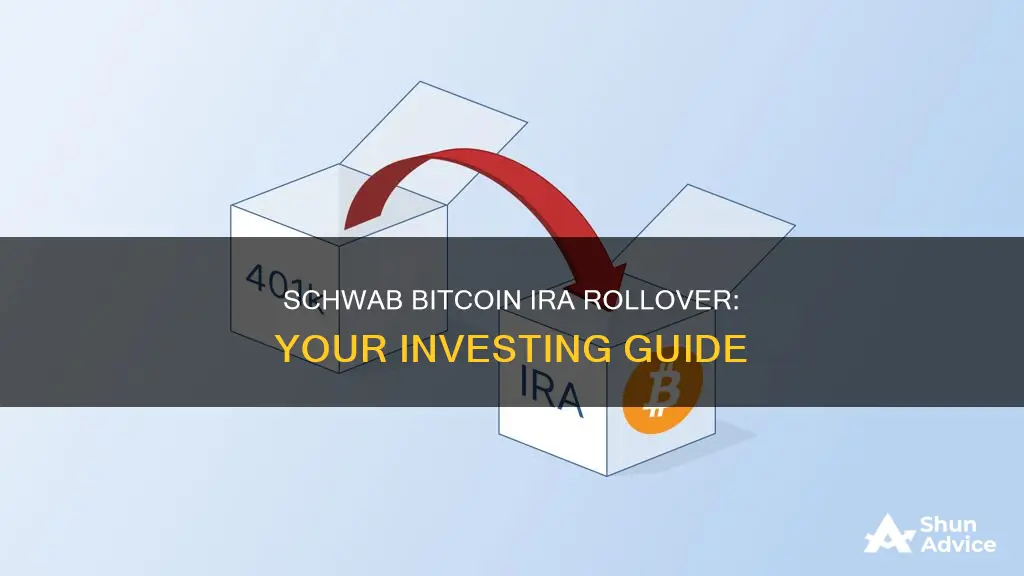
Investing in Bitcoin with a Rollover IRA from Schwab is a complex process with many steps. A Rollover IRA is an account that allows you to move funds from your previous employer-sponsored retirement plan into an IRA. This can be done through a direct or indirect rollover. While a direct rollover is a simple transfer of funds from your previous employer to your IRA, an indirect rollover involves receiving a check from your previous employer and depositing it into your IRA. It is important to note that there are tax implications and potential penalties associated with indirect rollovers. When rolling over your 401(k) to an IRA, you have several options, including Traditional IRAs, Roth IRAs, and Rollover IRAs. Each option has its own characteristics, tax implications, and investment choices. It is crucial to carefully consider your investment goals and seek professional advice before deciding how to invest your Bitcoin in a Rollover IRA with Schwab.
What You'll Learn

How to open a Rollover IRA account
A Rollover IRA is an account that allows you to move funds from your previous employer-sponsored retirement plan into an IRA.
To open a Rollover IRA account, you can follow these steps:
- Navigate to the "Accounts" section on the Schwab website and click on "Retirement" under "Open an Account".
- Understand the source of funds in your employer-sponsored plan. Your plan may contain a mix of pre-tax, post-tax, and Roth contributions, so it is recommended to speak with your previous plan sponsor or a tax advisor to identify your options.
- Click the "Start" button on the appropriate account summary, which in this case, is the Rollover IRA.
- Complete the guided walkthrough, providing personal details, selecting account features, and reviewing the account terms and conditions. This process should take about 10 minutes.
- Choose your funding preference: Direct Rollover or Indirect Rollover. For a Direct Rollover, your previous plan administrator will send a check directly to Charles Schwab, depositing the funds into your account. For an Indirect Rollover, your previous plan provider will issue a check to you, which you then deposit into your newly created Rollover IRA. Note that Indirect Rollovers may have tax implications and incur penalties if not handled correctly.
By opening a Rollover IRA account, you can consolidate your previous workplace retirement accounts and take control of your retirement savings.
Calculating Bitcoin Profits: A Guide to Investment Gains
You may want to see also

Direct vs. Indirect Rollover
When it comes to rolling over a prior retirement plan, you have two options: a direct rollover or an indirect rollover.
Direct Rollover
A direct rollover requires your previous plan administrator to send a check directly to your new plan administrator, such as Charles Schwab, thereby depositing the funds into your new account directly. With a direct rollover, you never take possession of your retirement assets, and no taxes are withheld. Generally, you don't take possession of the assets during the rollover, though it depends on your employer.
Indirect Rollover
An indirect rollover, on the other hand, requires your previous plan provider to issue you a check, which you then deposit into your new retirement account. This means you will possess the money until you deposit it in the new account, creating an opportunity to use the funds for any purpose during the limited 60-day window. With an indirect rollover, your previous plan administrator must withhold a portion of the funds to cover potential taxes, usually 20%. If you do not deposit the full amount into the new account, the amount not rolled over will be considered a distribution and will be subject to income tax and potential early distribution penalties.
Both direct and indirect rollovers allow you to move money from one qualified retirement account to another. However, there are several key differences between the two options. Firstly, with a direct rollover, the money is never in your possession, whereas an indirect rollover gives you access to the funds for a period of time. Secondly, a direct rollover does not incur taxes or penalties, while an indirect rollover may be subject to taxes and penalties if not handled correctly. Additionally, with a direct rollover, your full original balance is sent to the destination account, whereas an indirect rollover may hold back a portion of the funds for taxes.
It is important to note that the 60-day rule and the one-rollover-per-year rule do not apply to direct rollovers but do apply to indirect rollovers.
The Ultimate Guide to Buying Your First Bitcoin
You may want to see also

Funding your IRA account
Firstly, you will need to complete any forms required by your former employer. Next, decide how you want your retirement assets distributed. You can ask your employer to deposit your funds directly into your Schwab IRA. To prevent funds from being taxed, the check should be made payable to "Charles Schwab & Co., Inc., FBO [Your Name]".
You should also give your employer your Schwab IRA account number and ask them to include it on the check to avoid potential hold times. Instruct your employer to mail the check to: Charles Schwab & Co., Inc., P.O. Box 2339, Omaha, NE 68103.
If your employer made your rollover distribution check payable to you rather than to Schwab, you can still deposit it directly into your IRA. Be sure to write your Schwab IRA account number on the check and deposit it within 60 days to avoid taxes and penalties.
Your plan administrator may have withheld 20% for federal income tax. You can recover this deduction if you roll over the amount you received from your previous employer plus the 20% that was deducted. You will receive the refund in the form of a tax credit when you file your tax return.
The Ultimate Guide to Long-Term Ripple Bitcoin Investing
You may want to see also

Rollover IRA advantages
A Rollover IRA is a retirement account that allows you to move funds from your previous employer-sponsored retirement plan into an IRA without losing its tax-deferred status. Here are some advantages of a Rollover IRA:
Tax Advantages:
When you roll over your old retirement account into a Rollover IRA, you can preserve the tax-deferred status of your retirement assets. This means you won't have to pay current taxes or early withdrawal penalties at the time of transfer.
Wide Range of Investment Choices:
Rollover IRAs typically offer a broader selection of investments compared to a 401(k). With a Rollover IRA, you can choose from various investment options such as stocks, bonds, CDs, ETFs, and mutual funds to meet your retirement goals and risk tolerance.
No Account Fees:
With a Schwab IRA, for example, there are no account opening or maintenance fees, regardless of your account balance or trading frequency. This can help keep your overall costs low.
Consolidation of Old 401(k)s:
A Rollover IRA allows you to consolidate all your old 401(k)s into a single account, making it easier to manage your retirement savings.
Control and Flexibility:
With a Rollover IRA, you have more control over your portfolio and investment choices. You can buy and sell holdings anytime, giving you greater flexibility in managing your retirement funds.
Lower Fees:
Rolling over your 401(k) to an IRA can reduce management and administrative fees that eat into your investment returns over time.
Estate Planning Advantages:
IRAs offer more payout options upon your death, providing potential tax benefits for your beneficiaries.
Access to Tools and Guidance:
Rollover IRA providers often offer additional services, such as investing tools and guidance, to help you make informed decisions about your retirement savings.
The Ultimate Guide to Starting Bitcoin Investment
You may want to see also

Investment options
If you are looking to invest in Bitcoin using a Rollover IRA with Schwab, there are a few steps you need to take. Firstly, you need to open a Rollover IRA account, which allows you to move funds from your previous employer-sponsored retirement plan into an IRA. This is a tax-smart way to keep your money invested and access a wide range of investment choices.
Once you have opened your Rollover IRA, you can choose from a variety of investment options. Schwab offers a range of investment choices to fit your goals, including stocks, bonds, ETFs, mutual funds, and automated investing with Schwab Intelligent Portfolios®. You can also select from a wide range of investments with a Schwab IRA, including stocks, bonds, ETFs, mutual funds, and CDs.
It is important to note that you cannot invest directly in Bitcoin with a Schwab IRA. However, you can use the funds in your Rollover IRA to invest in a variety of other investment options, which may include Bitcoin-related funds or stocks. Be sure to review all your investment options carefully and consider seeking advice from a financial advisor to make informed decisions.
Additionally, it is worth noting that there are no account opening or maintenance fees for Schwab IRAs, and there is no minimum deposit required. This gives you the flexibility to invest in a variety of options to build a diverse portfolio that aligns with your retirement goals and risk tolerance.
Bitcoin Investment Trust: Tracking Bitcoin's Price
You may want to see also
Frequently asked questions
A Rollover IRA is an account that allows you to move funds from your previous employer-sponsored retirement plan into an IRA.
To open a Rollover IRA, navigate to "Accounts" and click "Retirement" under "Open an Account". You will then need to complete a guided walkthrough, which includes providing personal details, selecting account features, and reviewing the account terms and conditions.
There are two funding options for a Rollover IRA: Direct Rollover and Indirect Rollover. For a Direct Rollover, your previous plan administrator will send a check directly to Charles Schwab. For an Indirect Rollover, your previous plan provider will issue a check to you, which you will then deposit into your Rollover IRA.
Rolling over to an IRA allows you to preserve the tax-deferred status of your retirement assets without paying current taxes or early withdrawal penalties. Additionally, there are no account opening or maintenance fees, and you have a wide range of investment choices.
Eligible employer-sponsored retirement plans include 401(k) plans, 403(b) plans, profit-sharing plans, money purchase plans, and Keoghs/Qualified Retirement Plans (QRPs). Plans that may not be eligible include employee stock ownership plans (ESOPs) and defined benefit plans.







